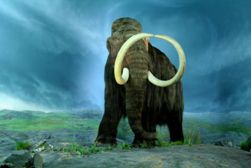
The Younger Dryas Impact Theory suffers yet another blow, reports Dwain Eldred
Geoscientist Online 31 August 2010
Diamonds might be a girl’s best friend but they are doing no favours to the now widely discredited “Younger Dryas Impact” theory, as a team of scientists casts heavy doubt upon the last remaining un-debunked evidence in support the hypothesis.
Just 12,900 years ago, gradual warming following the last Ice Age came to a halt, and glacial conditions were restored for a 1300-year interval known as the Younger Dryas. In North America, many large species (mammoths, mastodons, sabre-tooth tigers, giant short-faced bears) became extinct. A controversial theory has suggested that a comet or meteor airburst or impact may have been responsible.
In sedimentary deposits dating to the beginning of the Younger Dryas, proponents of this theory had reported carbon spherules containing tiny nano-scale diamonds, including lonsdaleite, a rare hexagonal (2H) diamond polytype, often associated with shock pressures related to impacts where it has been found to occur naturally.
However in a paper published by the Proceedings of the National Academy of Sciences (PNAS), a team of scientists shows that the original material reported as diamond appears to have been misinterpreted, and also that what had been previously reported as nanodiamonds are instead forms of carbon related to common graphite.
Dr Tyrone Daulton (Washington University in St. Louis) commented, “Of all the evidence reported for an Younger Dryas impact event, the presence of 2H hexagonal diamond in Younger Dryas boundary sediments represented the strongest evidence suggesting shock processing.”
However, close examination of carbon spherules from the Younger Dryas boundary using transmission electron microscopy found no nanodiamonds. Instead, graphene- and graphene/graphane- oxide aggregates were found to be ubiquitous in all specimens examined (including carbon spherules dated from before the Younger Dryas to the present). Importantly, previous studies were shown to have misidentified graphene/graphane- oxides as hexagonal diamond and probably also misidentified graphene as cubic diamond.
The Younger Dryas impact hypothesis was already in trouble before this latest finding – as reported earlier this year. Many other lines of evidence – including fullerenes, extraterrestrial forms of helium, purported spikes in radioactivity and iridium, and claims of unique spikes in magnetic meteorite particles – had already been discredited. According to co-author Professor Nicholas Pinter (Southern Illinois University) “nanodiamonds were the last man standing.”
Another report co-author Professor Andrew C. Scott (Royal Holloway, University of London), told
GeoscientistOnline: “we should always have a sceptical attitude to new theories and to test them thoroughly, and if the evidence goes against them they should be abandoned”.
Reference
- Daulton, T et al., August 2010. No evidence of nanodiamonds in Younger-Dryas sediments to support an impact event. Proceedings of the National Academy of Sciences, doi/10.1073/pnas.1003904107